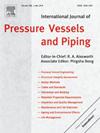Evolution behavior of residual contact pressure of hydraulic expanded joints with groove in steam generator under creep conditions
IF 3
2区 工程技术
Q2 ENGINEERING, MECHANICAL
International Journal of Pressure Vessels and Piping
Pub Date : 2025-03-17
DOI:10.1016/j.ijpvp.2025.105510
引用次数: 0
Abstract
The hydraulic expanded joint with grooves (HEJ-G) is a critical zone in steam generators, and the creep action may impact the residual contact pressure and the joint performance. However, the evolution behavior of the residual contact pressure of the HEJ-G under creep conditions is rarely reported. Based on this, this work addressed the evolution behavior of the residual contact pressure of the HEJ-G in steam generator. A three-dimensional finite element model was developed to simulate the creep behavior of the joints. The distribution and evolution behaviors of the contact pressure and the axial strength for different expanding pressures were discussed. The influence of the tube-side pressure on the average contact pressure of the joints was reported. The results indicated that the residual contact pressure values in various regions decrease in the creep exposure time. The evolution behaviors of the contact pressure of the joint are dependent on the expanding pressure. The remarkable stress relaxation or stress re-distribution can happen, and the steady-state stress level is related to the positions. The tube-side pressure can strength the contact effect between the tube and the tubesheet, resulting from the radial deformation of the tube. The enhancement of the contact pressure increases with the expanding pressure.
蠕变条件下蒸汽发生器带槽水力膨胀节残余接触压力演化行为
带沟槽的水力膨胀接头是蒸汽发生器的一个关键区域,其蠕变作用会影响接头的残余接触压力和性能。然而,在蠕变条件下,HEJ-G残余接触压力的演化行为鲜有报道。在此基础上,研究了蒸汽发生器内HEJ-G残余接触压力的演化规律。建立了三维有限元模型来模拟节点的蠕变行为。讨论了不同膨胀压力下接触压力和轴向强度的分布和演化规律。研究了管侧压力对接头平均接触压力的影响。结果表明,随着蠕变暴露时间的延长,各区域的残余接触压力值逐渐减小。接头接触压力的演化行为依赖于膨胀压力。应力会发生明显的松弛或再分布,稳态应力水平与位置有关。管侧压力可以增强管与管板之间的接触效应,这是由于管的径向变形造成的。接触压力的增强随膨胀压力的增大而增大。
本文章由计算机程序翻译,如有差异,请以英文原文为准。
求助全文
约1分钟内获得全文
求助全文
来源期刊
CiteScore
5.30
自引率
13.30%
发文量
208
审稿时长
17 months
期刊介绍:
Pressure vessel engineering technology is of importance in many branches of industry. This journal publishes the latest research results and related information on all its associated aspects, with particular emphasis on the structural integrity assessment, maintenance and life extension of pressurised process engineering plants.
The anticipated coverage of the International Journal of Pressure Vessels and Piping ranges from simple mass-produced pressure vessels to large custom-built vessels and tanks. Pressure vessels technology is a developing field, and contributions on the following topics will therefore be welcome:
• Pressure vessel engineering
• Structural integrity assessment
• Design methods
• Codes and standards
• Fabrication and welding
• Materials properties requirements
• Inspection and quality management
• Maintenance and life extension
• Ageing and environmental effects
• Life management
Of particular importance are papers covering aspects of significant practical application which could lead to major improvements in economy, reliability and useful life. While most accepted papers represent the results of original applied research, critical reviews of topical interest by world-leading experts will also appear from time to time.
International Journal of Pressure Vessels and Piping is indispensable reading for engineering professionals involved in the energy, petrochemicals, process plant, transport, aerospace and related industries; for manufacturers of pressure vessels and ancillary equipment; and for academics pursuing research in these areas.

 求助内容:
求助内容: 应助结果提醒方式:
应助结果提醒方式:


